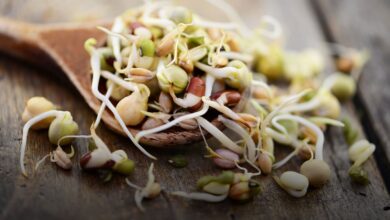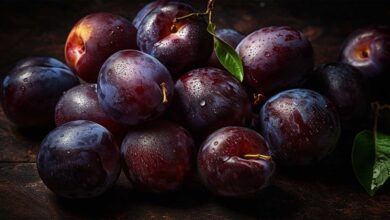Properties and functions of carbohydrates

Carbohydrates (formerly called carbohydrates) are large molecules composed of carbon, hydrogen, and oxygen. The body uses carbohydrates primarily to produce energy quickly. The two main types of carbohydrates are simple carbohydrates, which have a structure consisting of one or two sugars, and complex carbohydrates, which have a structure consisting of several sugars linked together. All carbohydrates have certain characteristics in common, including:
- Simple carbohydrates have a ring structure;
- Complex carbohydrates have a linear or branched structure.
- Carbohydrates are created by the dehydration reaction of simple sugars.
- Simple carbohydrate names end in “-ose”;
- Carbohydrates are used to provide energy in living organisms.
Examples of carbohydrates
There are many examples of carbohydrates. Here are some biologically important examples

Image rights © Adobe Stock
Carbohydrates constitute an important part of the human diet. Here are the most common sources of carbohydrates:

Image rights © Adobe Stock
Characteristics of carbohydrates
Compositions
Carbohydrates consist of the following elements: carbon, hydrogen, and oxygen. Each carbon atom is bonded to at least one oxygen atom. All carbohydrates include an aldehyde or ketone group and a hydroxyl group. Carbohydrates can form long chains, either linear or branched. But, regardless of their final structure, all complex carbohydrates are made up of individual units called monosaccharides, or simple sugars. Each monosaccharide has the carbohydrate formula: CH2, where n is a number greater than two.
Physical properties
Carbohydrates are a diverse class of macromolecules and therefore have different physical properties. Glucose, for example, is a white crystalline powder at room temperature. It has a melting point of 153 to 156 degrees Celsius. Starch is a complex carbohydrate and contains many glucose molecules linked together. Due to this greater complexity, it has a higher melting point of between 256 and 258 degrees Celsius. At room temperature, starch is also a white crystalline powder.
Species
Carbohydrates can be classified based on the number of sugars present in the molecule. The table below summarizes the three types of carbohydrates and gives examples.
| Type of carbohydrates | Number of sugars | Examples |
|---|---|---|
| Monosaccharides | Sugar | Glucose, fructose |
| Disaccharide | Two sugars | Lactose and sucrose |
| Polysaccharide | Three or more sugars | Starch and cellulose |
communication
Monosaccharides are linked by glycosidic bonds. This type of bond is only found in carbohydrates and connects two monosaccharides with an ether group. Glycosidic bonds are classified based on the elements involved in the bond with the carbon. Most glycosidic bonds use only carbon, hydrogen, and oxygen, but some may use sulfur or nitrogen. For example, an N-glycosidic bond is a carbon atom attached to a nitrogen and is common if carbohydrates are added to proteins.
Glycosidic bonds are created by a dehydration reaction, also known as a condensation reaction. During this reaction, the hydroxyl group attached to the carbon atom leaves the hydrogen atom of the other group, forming water. There are two main types of glycosidic bonds, the 1,4-glycosidic bond and the 1,6-glycosidic bond. These two types of bonds rely on carbon atoms attached to monosaccharides. From these two types of glycosidic bonds the structure of the carbohydrate chain is determined. The 1,4-glycosidic bond creates a linear structure and the 1,6-glycosidic bond creates a branched structure.
There are also two types of bonds, alpha and beta, which depend on the stereochemistry of the bond. If the bond is formed below the glucose chain, the bond is alpha, and if the bond is formed above the chain, the bond is beta. This has important implications for humans, because the digestive system is only able to break down alpha bonds. Therefore, plant carbohydrates such as cellulose that use beta bonds cannot be broken down and absorbed.
Dissolution
This chemical structure gives carbohydrates their physical properties. Carbohydrates are generally soluble in water due to the polarity of the bonds between oxygen and other atoms in the molecule. This polarity allows hydrogen bonding between carbohydrates and water.
These properties allow carbohydrates to serve as a fuel source for living organisms by being oxidized during cellular respiration.
Functions of carbohydrates
The main function of carbohydrates is to provide quick energy to the body, but they also have other secondary functions.
Fast energy
Organisms use carbohydrates as a quick source of energy. Glucose is the primary fuel source for cellular respiration and is the fuel source that can be used most quickly. During cellular respiration, cells use oxygen and glucose to produce ATP, or energy, and carbon dioxide and water as waste. Larger carbohydrates such as glycogen and starch are broken down into simple sugars for use in cellular respiration.
Energy storage
Carbohydrates can also be used to store energy for times when simple sugars are not available. In animals, carbohydrates are stored as glycogen. In plants, carbohydrates are stored as starch, which consists of two complex sugars, amylopectin and amylose. Humans can eat many of these plants as food, such as potatoes, peas, or corn.
Regulating metabolism
The availability of carbohydrates also regulates the metabolism of other macromolecules such as proteins and fats. Carbohydrates are the body's preferred fuel source and are therefore preferred over other macromolecules. This prevents important structural proteins from being broken down for fuel.
Cellular signaling
Carbohydrates are also used in cell signaling. Many animal cells contain extracellular carbohydrates linked to membrane lipids or proteins by glycosidic bonds. These surface carbohydrates contribute to cellular recognition and help the cell recognize the host from foreign cells.
building
Carbohydrates are also structurally important. In plants, cellulose is an important component of the cell wall and helps provide rigid structure and support for the plant. Chitin is a type of carbohydrate used in the cell walls of fungi and in the exoskeleton of arthropods and some marine animals. In animals, carbohydrates are an important part of the extracellular matrix, helping to hold cells in place and provide a framework for tissues.
Uses of carbohydrates
Organisms use carbohydrates primarily to provide energy. However, the human body also needs carbohydrates for other uses. Fiber, such as cellulose, is especially important for digestion. They help food move through the digestive system and prevent constipation. In industry, cellulose is used to make pulp and paper. Glucose can also be used as a raw material for fermentation and in the chemical production industry.
Properties and functions of carbohydrates


